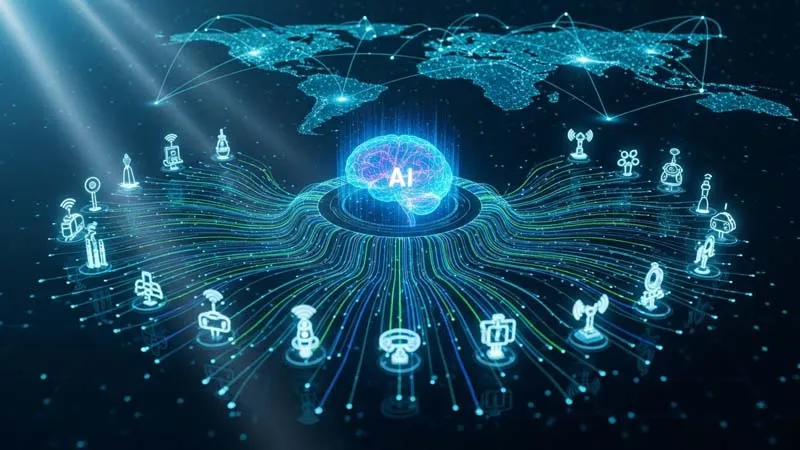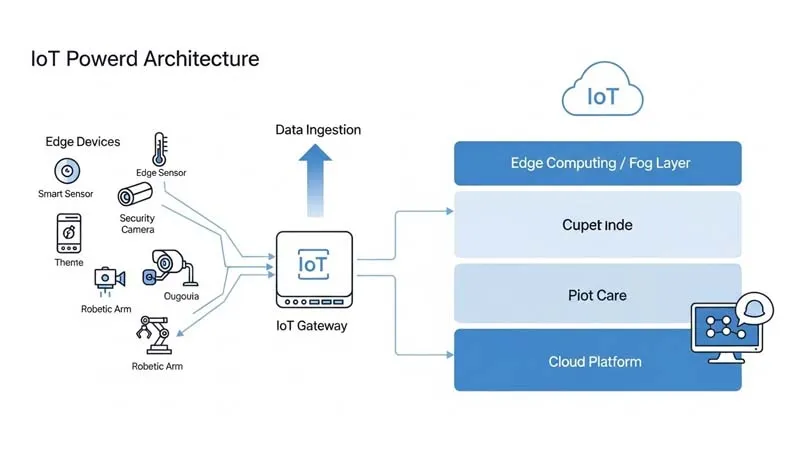An IoT Platform is entering a new stage of growth. As global industries push toward deeper digital transformation, simple device connections are no longer enough. Companies now expect clearer insights, stronger predictions, and faster automated actions. Because of this shift, AI large models are transforming every layer of the IoT Platform. With enhanced reasoning and real-time decision-making, the platform is becoming the intelligent brain of modern business operations.

1. AI Turns the IoT Platform Into an Intelligent Decision Center
Traditional platforms focus on data collection, alerts, and device management. However, these functions cannot answer deeper questions, such as why an issue occurs or what may happen next. AI large models change this situation. They bring stronger reasoning, broader knowledge, and better pattern understanding.
Moreover, they read the meaning behind data changes. In addition, they predict business trends using both time-series signals and context. As a result, the IoT Platform shifts from passive monitoring to active intelligence.

2. AI Helps the IoT Platform Solve Long-Standing Industry Challenges
Many companies face familiar obstacles during digital transformation. However, AI now provides practical ways to overcome these limitations.
1) Low accuracy caused by fragmented data
Devices vary widely across industries. Therefore, traditional models often struggle with data gaps. AI large models, however, learn across multiple scenes and reduce the cost of adaptation.
2) Slow response caused by manual judgment
Older alert systems produce many signals but few explanations. Consequently, operators must review and filter them by hand. With AI, alerts can be merged into meaningful events. Moreover, the system evaluates severity and suggests response steps, which speeds up decision-making.
3) Difficult expansion across industries
Past deployments required new rules for each sector. However, AI large models allow easier reuse of logic. As a result, the IoT Platform can scale across industries more efficiently.
3. Industry-Specific AI Models Further Enhance the IoT Platform
Many sectors now build specialized AI models. These models combine expert rules, workflows, and historical data. Therefore, the IoT Platform gains more professional intelligence.
For example:
- Manufacturing improves maintenance prediction and quality checks.
- Energy systems raise load forecasting accuracy and increase scheduling efficiency.
- Logistics and fleet management detect route risks and abnormal stops faster.
- Smart cities spot equipment faults early and suggest rapid actions.
Consequently, the IoT Platform becomes both smarter and more industry-ready.

4. AI Reshapes the IoT Platform Architecture
The platform is no longer only a device management tool. Instead, it is turning into a complete intelligent system.
1) Intelligence from edge to cloud
Edge models process fast local data. Meanwhile, cloud models combine large-scale information for deeper reasoning. Therefore, the entire chain gains smart capability.
2) AI Agents enable autonomous operations
AI Agents now perform tasks such as generating suggestions, creating work orders, and executing device recovery flows. As a result, the IoT Platform gains continuous, automated support.
3) Natural-language automation replaces complex scripting
Earlier, teams needed technical skills to design workflows. Now, however, simple natural-language commands can build automation flows. This greatly reduces deployment time.
4) Knowledge-enhanced reasoning makes decisions more accurate
With RAG technology, the platform merges real-time data with domain knowledge. Consequently, decisions become more explainable and more reliable.
5. AI-Driven IoT Platforms Deliver Clear Business Value
AI brings measurable gains that help companies operate more efficiently:
- 20%–60% better prediction accuracy
- Over 50% fewer false alerts
- 70%–90% automation in issue handling
- Earlier fault detection with hours or days of advance warning
- Lower overall cost and higher operational efficiency
Furthermore, these improvements appear across manufacturing, logistics, and energy sectors. As a result, AI has become a strategic requirement rather than an optional upgrade.
6. The Future: The Rise of AI-Native IoT Platforms
As AI continues to evolve, the next-generation IoT Platform will follow several clear trends.
- It will shift from an “application tool” into an “enterprise intelligence center.”
- A three-layer system will form: general models, industry models, and enterprise models.
- AI Agents will become essential digital workers who support daily operations.
- Data-driven decisions will increasingly shape business competitiveness.
Therefore, intelligence will define the next wave of platform innovation.

Conclusion: Smart IoT Becomes the New Industry Standard
The IoT Platform is evolving from a simple data container into a true intelligent brain. With AI large models, it can understand context, predict risks, and support sustainable business growth. Moreover, it will continue to improve as new knowledge and smarter reasoning mechanisms are added.
Recognizing this shift, EELINK Communication continues to expand its leadership in IoT hardware and wireless communication. With more than twenty years of experience, the company creates reliable monitoring devices and platforms for temperature control, asset tracking, vehicle security, insurance, and cold-chain logistics. Through continuous innovation, EELINK Communication helps global customers build efficient, stable, and intelligent IoT systems that deliver real and lasting value.
